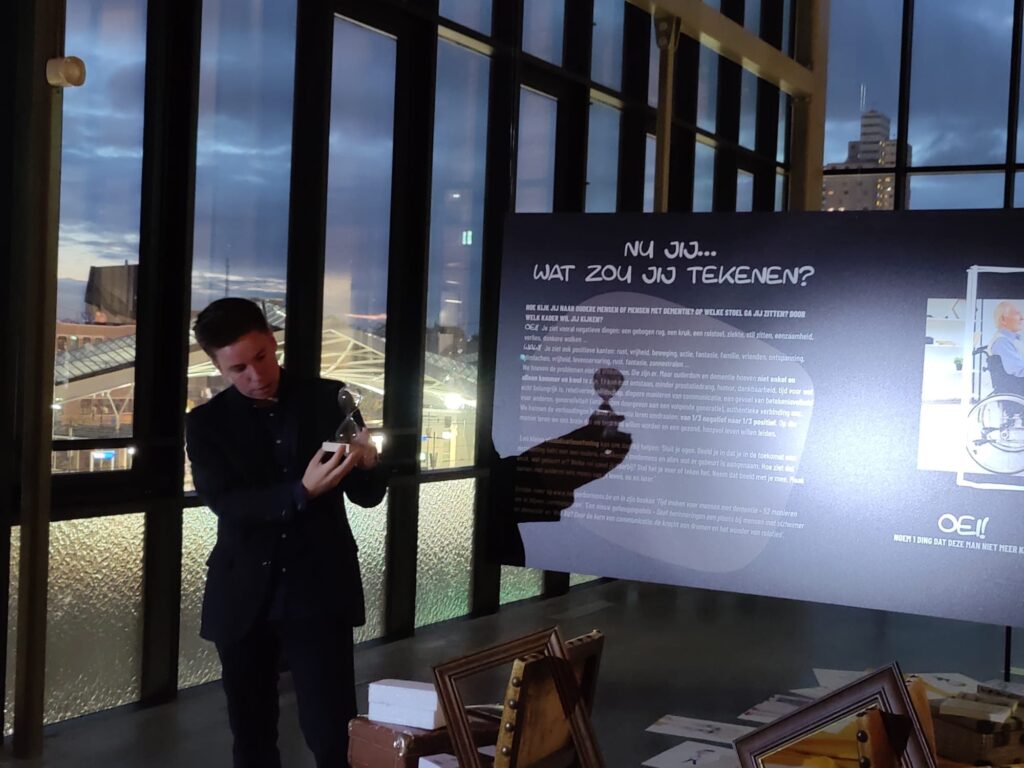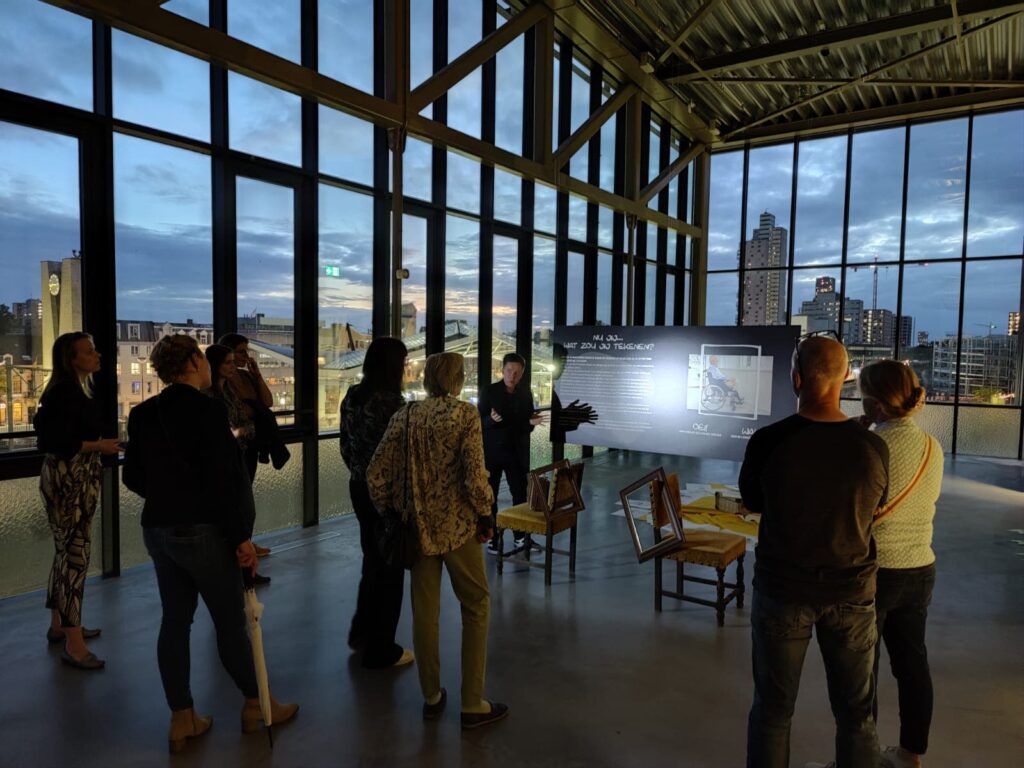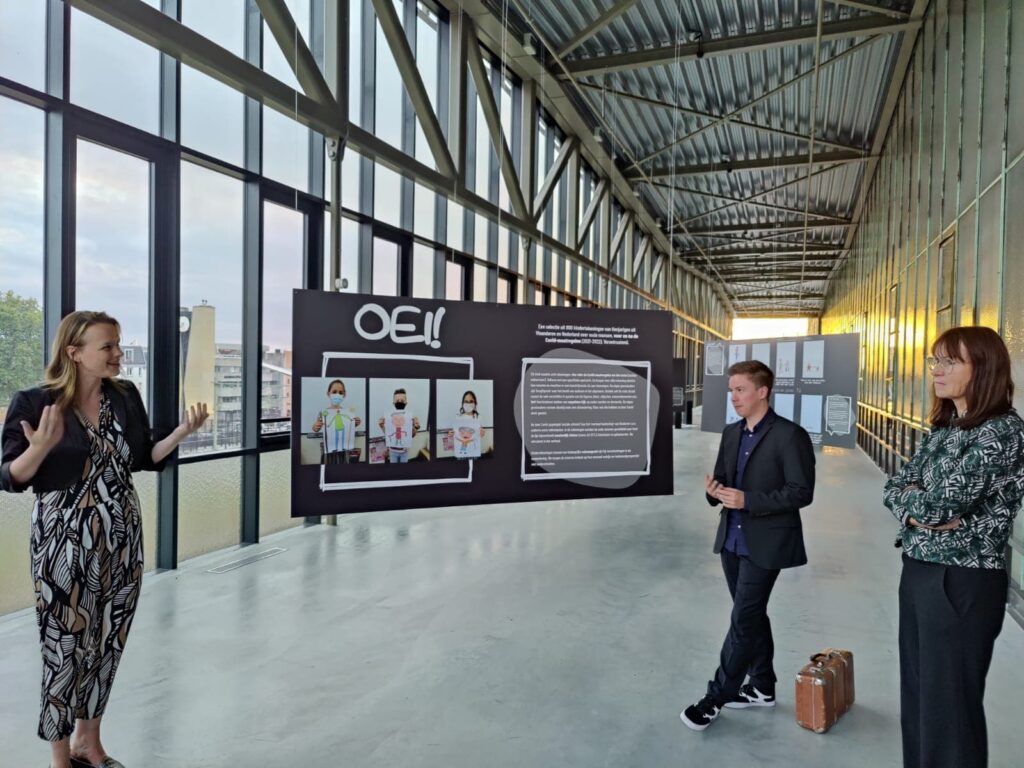Oh! Grandfather suddenly is so small!’
The Impact of Covid on Children’s drawings
LocHal Tilburg
Exposition: 1 – 23 September 2022
What is Covid doing to children’s mental well-being? Questionnaires are not the most suitable means to find out. Dr. Kasper Bormans (Maastricht University) investigates this through scientific analysis of 800 children’s drawings made in Belgium and The Netherlands. The first results show that the children developed a particularly negative view on ‘old people’ in a short period of time. For example, almost all drawings became considerably smaller: on average about 33 percent. That’s not a good sign. The social distance in reality appears to be visible in the drawing. But there is hope, we can bring generations closer together, making the figures in the sketches taller again. This is evident from the positive interventions of ‘What Alz? – Child as Force’. We can go from ‘Oh’ to ‘Awe’!
Doctor Kasper Bormans presented the first results of his research at the International Alzheimer’s Conferences in London and San Diego (USA). For The Netherlands, the results will be presented in the beginning of the month September, in which attention is drawn to dementia worldwide. The drawings will be shown and explained during an out-of-the-box exhibition in the prestigious LocHal in Tilburg from September 1 to 23. There are, among other things, guided walks by eminent scientists such as psychiatrist Prof. Dirk De Wachter on the program. The research is conducted at Maastricht University and the exhibition is supported and made possible by Alzheimer Nederland.
Between October 2021 and February 2022, the children (10-11 years old) made 800 drawings in the classroom. Both from unknown elderly people and from their own grandparents in different situations: neutral, happy and unhappy. During the investigation, they unpredictably ended up in the fifth Corona wave, which led to quarantines, lockdowns with restrictions, face masks, keeping distance and limited visits. This resulted in a collection of unique research material. In the top 3 of what children missed during the Covid measures, in addition to the lack of friends and outside activities, the most prominent element is ‘the loss of contact with grandma and grandpa’.
The drawings were meticulously analyzed on many levels. And guess what? The most striking observation: almost all older people in the drawings became considerably smaller, on average up to 33 percent. That’s not a good sign. After all, shrinking figures in children’s drawings are a well-known signal of growing detachment and diminishing significance. The fact that Covid plays a major role in this is a very plausible hypothesis. The children apparently unconsciously developed a more negative view on older people. This adversely affects both their own quality of life and that of older people. But there is hope, it became apparent from the follow-up research and the intense conversations that Kasper Bormans had with the children and their teachers.
MENTAL LANDSCAPE

“It was painful to see children suddenly become portrayed as lepers compared to the elderly. They have often experienced it that way themselves,’ says schoolteacher Trudy, who worked on the project with her students. “Next to our school’s playground, there is a nursing home for people with Alzheimer’s. Our children had to stay far away from them. When adults also came to our playground to wave to their own parents who were sitting behind the windows of the nursing home, to make some eye contact possible, that sadness took on a face. It impacted all the children who saw that spectacle.”
The children’s drawing specialists Prof. Nicole Vliegen and Sus Weytens, affiliated with the KULeuven, follow the project very closely and are equally surprised and delighted: ‘Children’s drawings are an excellent means of investigating what goes on in children subconsciously. A great deal of international scientific expertise has been built up in recent years to examine the drawings and derive substantiated conclusions from them. For example, we can pay attention to colors, shapes, dimensions, proportions, facial expressions, symbols and the presence or absence of objects (such as houses, bicycles, carrousels, hospital beds or walkers) and natural elements (such as trees, flowers, rain, clouds or the sun).’ In the examined drawings we see almost all of these elements change. The fact that Covid plays an important role in this is certainly a plausible hypothesis. The effects of positive interventions are measurable and visible. These observations show that our mental landscape is malleable and open to change. We must be vigilant about the impact of negative events (such as Covid) on children. But at the same time, the research also gives us hope because we can really make a difference with small positive interventions.’
Doctor Kasper Bormans: “The research teaches us that we can change the mental landscape of children: externally (due to Covid, for example) or internally (through positive interventions). The impact of concrete positive interventions (such as a visit to a nursing home or playing ‘The Game of Imagination’ together with the grandparents) is immediately visible. Such interventions in parenting and education are not only necessary to eliminate the negative influence of Covid, they have a demonstrably positive effect on the way children view ‘aging’ and ‘dementia’. This benefits the children themselves, the elderly and society as a whole.”
FROM OH TO AWE
Doctor Kasper Bormans: ‘At first we were a little shocked by the unexpected results: Oh! But soon we also saw the exceptional possibilities in it. Because new Covid-19 social distancing measures were suddenly introduced during the research, we had a unique opportunity to compare the drawings of before and after the restrictions. Children who suddenly had to wear face masks for months, kept their distance and were not allowed to visit their grandparents, therefore had an accelerated negative view on aging and dementia.’
Prof. Hilde Verbeek (Maastricht University): ‘Unexpected results are often the most interesting findings. They motivate you to look for new explanations and discover alternative mechanisms. We were amazed by the children’s drawings, and only afterwards we started to realize that the children solely received one message from the social context: you have to keep your distance, the elderly are sick, vulnerable and can’t do anything, the elderly have to be protected… a lot of distance. And that message of keeping your distance also seems to be reflected in the shrinking human figures.’
Doctor Kasper Bormans: ‘When we later, after the Covid-19-wave in times of less restrictions, had children make drawings after small positive interventions, the figures turned out taller again: on average about 18 percent. Awe! That’s the good news: our mental landscape largely determines our behavior, but that landscape is changeable. That is why the baseline of our research is ‘From Oh to Awe’. What initially only seemed ominous (Oh!) contains enormous opportunities for upbringing and education (Awe!).’ The perception of aging and dementia is changeable. That is why the research and the exhibition are also supported and embraced by Alzheimer Nederland.’
Psychiatrist and Professor Dirk De Wachter (KULeuven) beams with pleasure at the drawings. “We can learn a lot from this,” he says. “Successful communication is essentially about kind and calm proximity. If we see that emotional closeness decreases, it makes a personal approach more difficult. This research explores an intergenerational interaction that brings more humanity to the problems of aging and dementia. That is very essential.”
CHILDREN AS FORCE

Also clinical psychologist and grief expert Prof. Manu Keirse (KULeuven) is following the research with great interest: ‘The elderly are actually the most differentiated group, and yet we have a very one-sided, usually negative image of them. Children are still flexible enough to defrost such a ‘frozen mental image’ and creative enough to fill it in in a positive way with our help. You can thaw, change and refreeze those frozen images. That is why this research is so hopeful.”
“As long as there is no wonder-pill for dementia, the carer is the best cure,” says Dr. Kasper Bormans. Every child has on average one grandparent with dementia and that number will only grow. Personalized communication plays a major role. After all, we can’t communicate with ‘someone’ but only with ‘the image we have of someone’. The images we have in our mental landscape are therefore crucial. If we can already adjust these images in children, parents and teachers, we learn to deal better with the elderly and with people with dementia. For that reason, we consider “each child as a force.” That way, children are not hidden victims of dementia, but hidden resources. Ultimately, they can elaborate on a number of positive qualities that adults need to cope with a problem situation such as dementia: enthusiasm, spontaneity, open-mindedness, humor, positivity, curiosity, connectedness, lust for life and empathy. When visiting the nursing home with the primary school class, for example, an old lady with dementia tells a child that it is very ‘open and intelligent’. The child immediately asks how she knows that. To which the old lady replies: ‘You are the only one who comes to visit here, who looks me straight in the eye. Other people look next to me or right through me.’ Such intergenerational conversations open up new worlds on both sides.”
PERSPECTIVE
The participating schools, the children as well as their teachers and (grand)parents are very enthusiastic. Just like the older people in nursing homes and residential care centers who were involved in the study. This is apparent from the project ‘What Alz – Children as Force’.

Prof. Sandra Zwakhalen (Nursing Sciences, Maastricht University) supervises the research: ‘What is very innovative about this project is the way we look at the living environment of children and the elderly with dementia based on children’s drawings. The evolutions in the drawings contain a valuable and socially relevant message. Now that we know more about the perspective from which children view the elderly, we can respond to this in a well-substantiated manner. Stimulating this intergenerational contact is of particular social importance, both for our view of dementia and for our interaction and communication with older people in general.”
…………………………………………………………………………………………………………………………………………………………………..
Doctor Kasper Bormans (°1987) obtained his doctorate in 2020 as a member of the Leuven School for Mass Communication Research (KULeuven) under supervision of Prof. Keith Roe (Social Sciences, KULeuven) and the well-known psychiatrist Prof. Dirk De Wachter (Psychiatry, KULeuven). Kasper is the author of books such as ‘What Alz?’ and ‘Making time for people with dementia – 52 ways to keep on communicating’. Affiliated with Maastricht University and supported by Alzheimer Nederland, he now conducts intergenerational research into improving the quality of life of children and vulnerable elderly people, more specifically into the role of connection, imagination and wonder in communication with people with dementia. For ‘What Alz – The Child as a Force’ he studies the positive characteristics of children in order to alleviate the burden of dementia for those involved and for society.
There is international attention for the method and the results of this research. Doctor Kasper Bormans was recently invited to give presentations at the two largest international conferences: Alzheimer’s Disease International Conference (London, June 2022) and Alzheimer’s Association International Conference (San Diego, August 2022). In October 2022 he will speak at the Alzheimer Europe Conference in Bucharest.
For this specific project in Tilburg, there was a close collaboration with the Montessori Primary School De Elzen in Tilburg and Nursing Home De Herbergier within walking distance of the school.
The research and the artistic exhibition are supported and made possible by Alzheimer Nederland.
For more background information and the agenda, visit: www.kasperbormans.be
